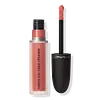What's inside
What's inside
 Key Ingredients
Key Ingredients

 Benefits
Benefits

No benefits
 Concerns
Concerns

 Ingredients Side-by-side
Ingredients Side-by-side

Dimethicone
EmollientVinyl Dimethicone/Lauryl Dimethicone Crosspolymer
Diisostearyl Malate
EmollientPolyglyceryl-2 Triisostearate
EmulsifyingTribehenin
EmollientSilica
AbrasiveQuartz
AbrasiveAlumina
AbrasivePolymethylsilsesquioxane
Sorbitan Isostearate
EmulsifyingCetyl PEG/PPG-10/1 Dimethicone
EmulsifyingVp/Hexadecene Copolymer
Tocopheryl Acetate
AntioxidantPhenoxyethanol
PreservativeCI 77492
Cosmetic ColorantCI 77491
Cosmetic ColorantCI 77499
Cosmetic ColorantCI 77891
Cosmetic ColorantCI 15850
Cosmetic ColorantCI 42090
Cosmetic ColorantDimethicone, Vinyl Dimethicone/Lauryl Dimethicone Crosspolymer, Diisostearyl Malate, Polyglyceryl-2 Triisostearate, Tribehenin, Silica, Quartz, Alumina, Polymethylsilsesquioxane, Sorbitan Isostearate, Cetyl PEG/PPG-10/1 Dimethicone, Vp/Hexadecene Copolymer, Tocopheryl Acetate, Phenoxyethanol, CI 77492, CI 77491, CI 77499, CI 77891, CI 15850, CI 42090
Dimethicone
EmollientDimethicone Crosspolymer
Emulsion StabilisingIsononyl Isononanoate
EmollientPolyglyceryl-2 Triisostearate
EmulsifyingDiisostearyl Malate
EmollientTribehenin
EmollientTocopheryl Acetate
AntioxidantLecithin
EmollientEthylhexyl Palmitate
EmollientIsopropyl Myristate
EmollientPolyglyceryl-3 Polyricinoleate
EmulsifyingPolyglyceryl-2 Diisostearate
EmulsifyingSorbitan Isostearate
EmulsifyingDehydroacetic Acid
PreservativeIsostearic Acid
CleansingPolyhydroxystearic Acid
EmulsifyingVanillin
MaskingMica
Cosmetic ColorantCI 77891
Cosmetic ColorantCI 77491
Cosmetic ColorantCI 77492
Cosmetic ColorantCI 77499
Cosmetic ColorantCI 42090
Cosmetic ColorantCI 15850
Cosmetic ColorantCI 45380
Cosmetic ColorantCI 45410
Cosmetic ColorantCI 17200
Cosmetic ColorantCI 19140
Cosmetic ColorantCI 15985
Cosmetic ColorantDimethicone, Dimethicone Crosspolymer, Isononyl Isononanoate, Polyglyceryl-2 Triisostearate, Diisostearyl Malate, Tribehenin, Tocopheryl Acetate, Lecithin, Ethylhexyl Palmitate, Isopropyl Myristate, Polyglyceryl-3 Polyricinoleate, Polyglyceryl-2 Diisostearate, Sorbitan Isostearate, Dehydroacetic Acid, Isostearic Acid, Polyhydroxystearic Acid, Vanillin, Mica, CI 77891, CI 77491, CI 77492, CI 77499, CI 42090, CI 15850, CI 45380, CI 45410, CI 17200, CI 19140, CI 15985
Ingredients Explained
These ingredients are found in both products.
Ingredients higher up in an ingredient list are typically present in a larger amount.
Ci 15850 is the pigment color red. It is an azo dye and created synthetically.
Azo dyes need to be thoroughly purified before use. This allows them to be more stable and longer-lasting.
This ingredient is common in foundations, lipsticks, and blushes. This color is described as brown/orangey red.
It has many secondary names such as Red 6 and Red 7. According to a manufacturer, Red 6 usually contains aluminum.
Learn more about CI 15850Ci 42090 is a synthetic dye created from petroleum. It is used to give a bright blue color to cosmetics, medicine, and food.
Ci 77491 is also hydrated iron III oxide. It's sole purpose is to give a red/pink hue to products.
Iron III oxides are classified as inorganic chemicals for coloring.
Synthetically created Ci 77491 is considered safer than those naturally found. This is because the synthetically created version may contain less impurities. Iron oxides are generally non-toxic and non-allergenic.
Learn more about CI 77491Ci 77492 is also hydrated iron III oxide. It's sole purpose is to give a yellow hue to products.
Iron III oxides are classified as inorganic chemicals for coloring.
Synthetically created Ci 77492 is considered safer than those naturally found. This is because the synthetically created version may contain less impurities. Iron oxides are generally non-toxic and non-allergenic.
Learn more about CI 77492Ci 77499 is also hydrated iron III oxide. It is created from mixing red and black iron oxides. This helps give shades of darkness to a product.
Iron III oxides are classified as inorganic chemicals for coloring.
Ci 77891 is a white pigment from Titanium dioxide. It is naturally found in minerals such as rutile and ilmenite.
It's main function is to add a white color to cosmetics. It can also be mixed with other colors to create different shades.
Ci 77891 is commonly found in sunscreens due to its ability to block UV rays.
Learn more about CI 77891Diisostearyl Malate is an emollient and most often used in lip products. It comes from isostearyl alcohol, a fatty acid, and malic acid, an AHA.
As an emollient, Diisostearyl Malate helps create a thin film on your skin to trap moisture in. This helps keep your skin soft and smooth.
Dimethicone is a type of synthetic silicone created from natural materials such as quartz.
What it does:
Dimethicone comes in different viscosities:
Depending on the viscosity, dimethicone has different properties.
Ingredients lists don't always show which type is used, so we recommend reaching out to the brand if you have questions about the viscosity.
This ingredient is unlikely to cause irritation because it does not get absorbed into skin. However, people with silicone allergies should be careful about using this ingredient.
Note: Dimethicone may contribute to pilling. This is because it is not oil or water soluble, so pilling may occur when layered with products. When mixed with heavy oils in a formula, the outcome is also quite greasy.
Learn more about DimethiconeThis ingredient is a form of glycerin with emulsifying and emollient properties.
As an emulsifier, this ingredient helps keep products together while adding a thick texture. The manufacturer states this ingredient has emollient properties. Emollients help keep the skin hydrated by trapping moisture in.
Polyglyceryl-2 Triisostearate is created by reacting diglycerin and isostearic acid. Due to the isostearic acid base, it may not be safe for Malassezia or fungal acne.
Learn more about Polyglyceryl-2 TriisostearateSorbitan Isostearate is an emulsifer and cleaning agent. It is created from isostearic acid and sorbitol.
As an emulsifier, Sorbitan Isostearate prevents oils and water from separating.
Due to its isostearic acid base, it may not be safe for Malassezia or fungal acne.
Learn more about Sorbitan IsostearateTocopheryl Acetate is AKA Vitamin E. It is an antioxidant and protects your skin from free radicals. Free radicals damage the skin by breaking down collagen.
One study found using Tocopheryl Acetate with Vitamin C decreased the number of sunburned cells.
Tocopheryl Acetate is commonly found in both skincare and dietary supplements.
Learn more about Tocopheryl AcetateTribehenin comes from glycerin and behenic acid.
It is used as an emollient, or moisturizer. Emollients form a thin barrier on skin to prevent moisture from escaping.
This ingredient may not be Malassezia folliculitis, or fungal-acne safe.
Learn more about Tribehenin